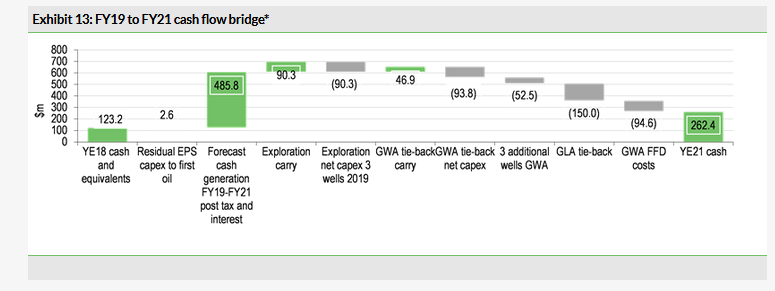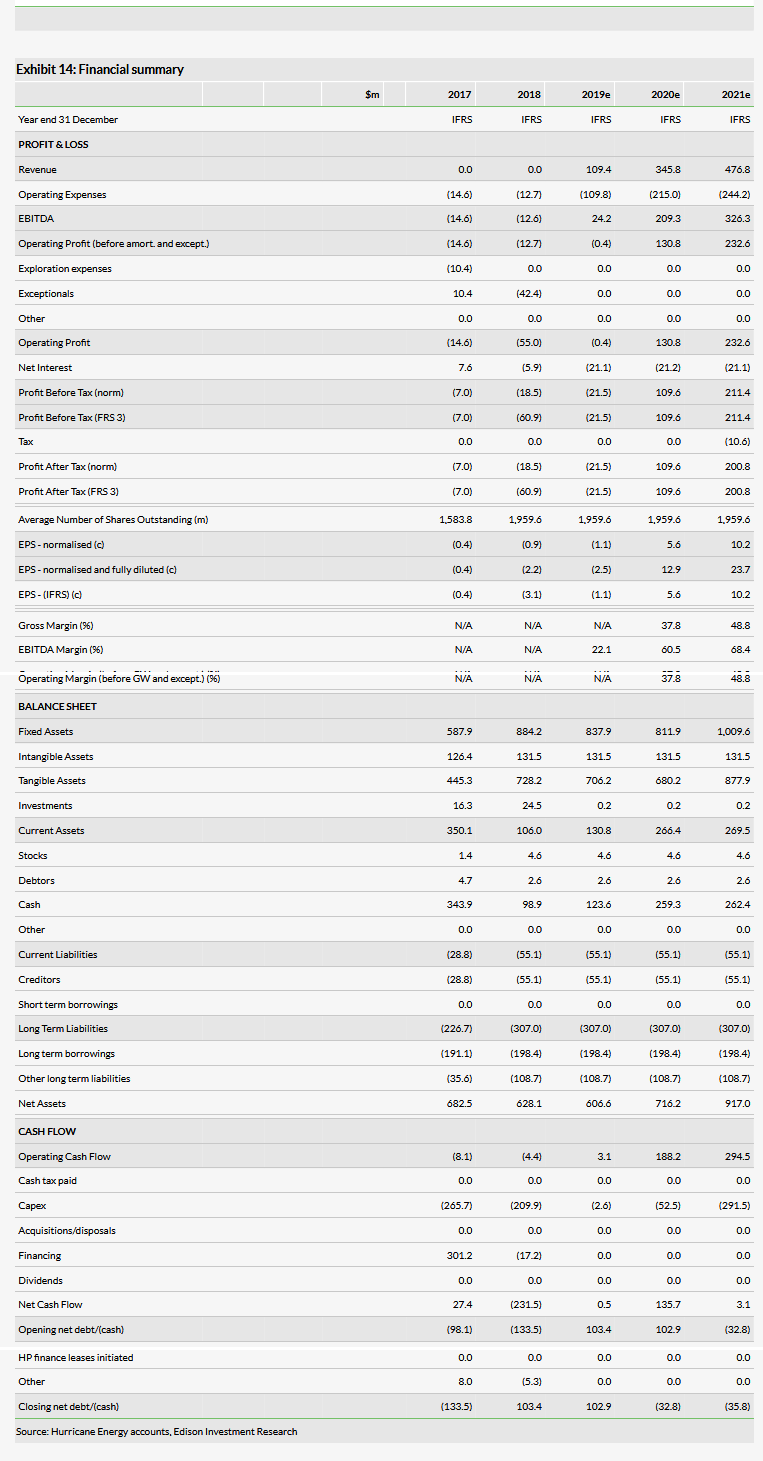With the Aoka Mizu FPSO now on station and hooked up at the Lancaster field, early production system (EPS) first oil remains on track for the end of H119. Hurricane Energy plc (LON:HUR) is currently focusing on topside commissioning prior to start up, which will be followed by a ramp-up period to a targeted gross plateau rate of 20kbd. In addition to progressing Lancaster, the company has a full programme of activity in its neighbouring Greater Warwick Area (GWA), with a three-well E&A programme expected to kick off in Q219 at Warwick Deep. This accelerated GWA programme is being made possible by Hurricane’s 2018 farm-out to Spirit Energy. Our risked valuation stands at 102.3p/share (from 102.8p/share) as we remove Edison’s 5% capex cost contingency, roll forward NAV and adjust our short-term oil price assumptions (long-term Brent remains $70/bbl).
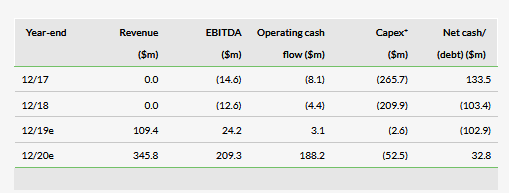
Lancaster EPS expectations
With the Aoka Mizu FPSO now successfully hooked up to the buoy, the focus shifts to commissioning, production performance and data gathering. Management guides at improving operational efficiency over the first six months of operation prior to stabilised production of 17kbd (net of operational downtime). We believe a minimum six- to 12-month period of data gathering will be required to begin to evaluate the long-term producibility of the reservoir.
Warwick Deep: Data input for 2020 programme
The Transocean Leader semi-sub is expected to begin the three-well GWA drilling programme with the Warwick Deep exploration well, 205/26b-C. This well is designed to be drilled below structural closure and to prove deep oil and will also provide key data for the planning of the 2020 GWA appraisal programme. Next to be drilled will be the Lincoln appraisal well. One of the three GWA wells is expected to be tied back to the Aoka Mizu in 2020 for long-term testing.
Valuation: Removing EPS capex contingency
Changes to our valuation are driven by the removal of EPS capex contingency (5%), rolling forward our NAV and a fall in short-term Brent price expectations, which are based on EIA forecasts. Our long-term (2022 onwards) Brent expectations remain at $70/bbl. Brent for FY19 falls from $73.7/bbl to $62.8/bbl and for FY20 from $71.9/bbl to $62/bbl. Our risked valuation is currently 102.3p/share; changes to our short-term financial forecasts are highlighted within this note.


Business description
Hurricane Energy is an E&P focused on fractured basement exploration and development in the West of Shetland region. The company’s 100%-owned Lancaster oil discovery (523mmbbl 2P reserves + 2C resources) is targeting first oil in H119.
EPS expectations: Commissioning and beyond
In the following section, we take a look at Edison’s expectations for the Lancaster EPS now that the Aoka Mizu FPSO is on location and hooked-up to the turret mooring system buoy. Subsea umbilicals, risers and flowlines (SURF) were connected to the buoy in H218, and a flow path now exists from both the 205/21a-6 and 205/21a-7z wells to the FPSO. The Aoka Mizu will now be commissioned ahead of first oil, which we believe remains on track for the back end of H119. Below we look at expectations for the Lancaster EPS development phase; these include:
Commissioning
First oil and production ramp-up
Flow assurance
Initial well productivity
EPS data gathering
Production ramp-up to 40kbd gross
Commissioning: From hook-up to first oil
Post hook-up, the Aoka Mizu will undergo a period of commissioning during which the FPSO topsides are prepared for the introduction of hydrocarbons. Commissioning is typically a labour-intensive process involving instrumentation checks, final machinery alignment, operational tests on rotating equipment and testing of safety critical systems ahead of introducing process fluids. In the case of a subsea tie-back this would typically be followed by the displacement of liquids within sub-sea flowlines, well clean-up, and introduction of hydrocarbons into the production facilities. The duration of an FPSO commissioning process can vary significantly and is often driven by the efficacy of final acceptance checks. The Aoka Mizu has been extensively tested and pre-commissioned both in dry-dock and offshore, mitigating the risk of major delays. Additionally, the vessel being a retro-fit of a previously operational FPSO rather than a newbuild or conversion provides additional assurances of the operational readiness of the vessel.
Looking at other North Sea FPSO developments there is a wide range of time durations from hook-up to first oil. The length of this interval can be driven by numerous factors including facility specific issues, size/complexity of the development and consideration of flow assurance issues, among others. Recent North Sea FPSO developments include the Premier Oil-operated Catcher FPSO, which achieved first oil just over nine weeks after the vessel was hooked up in 2017; it then took five months to reach plateau production. The EnQuest-operated Alma/Galia FPSO took five and a half months to first oil, reaching full-rate production five months later. EnQuest’s Kraken, albeit a much more complex development targeting 40kboed from 23 wells, took just 14 weeks from hook up to first oil, but incurred uptime issues during the vessel’s first few months of operation. As it stands, we remain comfortable in our estimate of first oil at the end of H119, but delays cannot be completely ruled out.
First oil, production ramp-up and uptime
We believe there is uncertainty around production expectations, at least during the first six months of EPS operation. Historical well test data provide some comfort of initial well delivery during the first six months of operation and operational efficiency assumptions are likely to be driven by vessel uptime rather than Hurricane choking back producing wells. Immediately following commissioning, Hurricane is targeting an initial gross production rate of 20kbd, estimating operating efficiency to be c 45% for the first three months and then 65% for the second three months of production before reaching a stabilised level of 85%, which includes downtime for pigging runs. This implies plateau production of 17kbd net of operating efficiency. Edison has not altered its EPS ramp-up production profile, which is broadly in line with Hurricane guidance and assumes late H119 start-up.
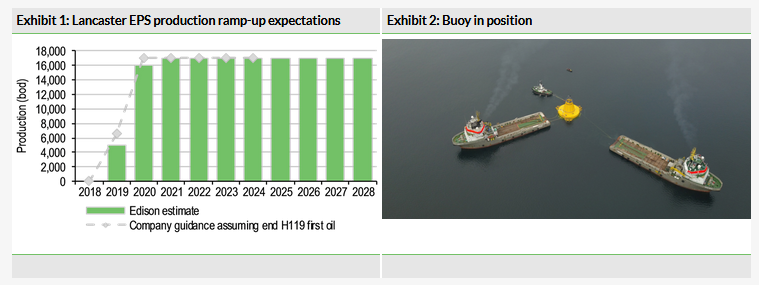
Flow assurance a key uptime consideration
Our understanding is that Lancaster crude has a 38°C wax appearance temperature, which is approximately 20°C lower than reservoir temperature. Wax management is therefore a key consideration for the project’s subsea and facility process engineers. The current wax management philosophy uses a combination of several components:
High U-value (insulation) flowlines.
Ability to inject wax suppressant/dissolver chemicals at the wellhead.
Ability to displace crude from flowlines for extended shutdowns.
Procedure to run a pig through a pigging loop (both flowlines) every two weeks. This involves a production shut-down for a short period and is reflected in Hurricane’s 85% vessel uptime assumption.
Crude inlet pre-heating.
During the first few months post first-oil Hurricane is likely to fine-tune production parameters and wax management philosophy. This would typically involve working within a production envelope and a floor in flow rate set by the need to sustain a sufficient oil rate in the subsea flowlines to avoid wax appearance (c 6kbd per flowline for Lancaster).
Confidence in initial well productivity
Hurricane is confident in EPS productivity given the low draw-down required to produce at 20kbd gross given the high calculated productivity index for both producers. This is based on 2014/2016 flow tests, which achieved constrained rates of 9.8kbd (205/21a-6) and 15.4kbd (205/21a-7z), respectively. Management does not see water breakthrough as a major risk with the existing producer pair, which is located in a crestal location c 430m from the known oil water contact. The EPS phase is targeting just 12% of Lancaster 2P reserves and 2C resources, and assuming this entire volume is connected, we believe pressure depletion during the EPS phase is likely to be limited. Assuming flow assurance is suitably addressed we expect initial well productivity to be in line with management expectations; the ability to maintain plateau production rates will then be determined by bottom hole pressure response – Hurricane currently models three cases as shown in Exhibit 4. We currently base our modelling around Hurricane’s mid-case.
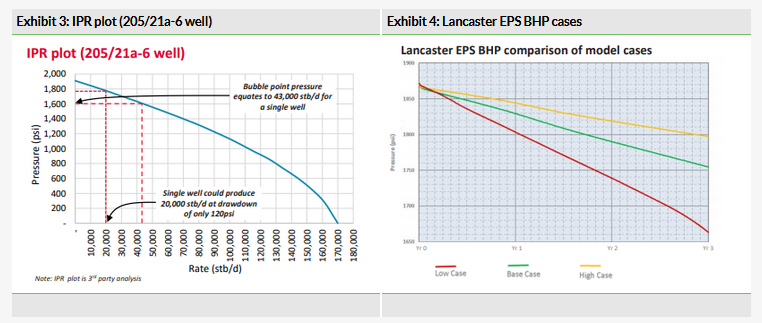
EPS data gathering
Once EPS production has stabilised, Hurricane’s focus is likely to shift to data gathering in order to enhance reservoir understanding. Hurricane expects that it will need at least six to 12 months of data from the two producing wells, 205/21a-6 and 205/21a-7z, in order to verify current modelling assumptions. Successful confirmation of basement modelling parameters will aid in the de-risking of Greater Lancaster Area (GLA) full field development. We believe Hurricane should be able to determine if downhole pressure data matches its low, base or high case models and interference testing between the two wells will also assist in assessing variations in reservoir horizontal and vertical permeabilities. These data will greatly assist in refining basement reservoir management practices. Finally, pressure build-up data will provide information on the reservoir further away from the wellbore. Although the initial EPS producers are located at a crestal location and high relative to oil water contact (OWC), pressure data should help provide some indication of interaction between oil and water within fractured basement. We believe a deeper well closer to the OWC might be required in order to provide greater understanding of water coning and channelling mechanisms. The Warwick Deep well to be drilled in 2019 on the GWA rather than GLA, is a deeper well outside of local structural closure which will be flow tested.
Aoka Mizu ramp-up to 40kbd gross
Hurricane Energy is looking at increasing Aoka Mizu FPSO output to c 40kbd, through new well additions (GLA and GWA) and de-bottlenecking. We see a gas export solution as a key enabler of further production enhancement, as incremental production is currently capped under existing flaring restrictions.
Gas export solutions
Hurricane has studied numerous gas evacuation solutions and appears to be progressing the opportunity to tie-in the Lancaster EPS to the BP-operated West of Shetlands pipeline systems (WOSPS). The WOSPS was installed in 2002 to transport surplus gas from the Foinaven and Schiehallion fields (Quad 204) to the Magnus field in the northern North Sea. Pipeline operator BP (LON:BP) currently indicates WOSPS available capacity in excess of 25% (of total capacity of 175mmscfd) through to 2023.
The capital cost of tie-in to WOSPS is uncertain at this point, but we estimate that this will require gas export compression to be added to the Aoka Mizu FPSO, a 10–20km flowline to WOSPS and associated sub-sea equipment to the enable tie-in to the WOSPS PLEM (pipeline end manifold). Hurricane currently estimates a gross cost of $187.5m for the SURF, well completion, FPSO modifications and WOSPS tie-in for a GWA well (phase II costs); Hurricane’s 50% equity interest would be c 50% carried under existing agreements. Hurricane Energy is also fully carried for its share of long-lead items and engineering work for the 2020 installation of the WOSPS tie-in (included within phase I of the GWA farm-in agreement).

De-bottlenecking
The combination of wells 205/21a-6 and 205/21a-7z have the potential to deliver significantly in excess of 20kbd gross, on an unrestricted basis based on historical constrained well test data. After initial data gathering is complete there is potential to increase production from the two wells assuming basement modelling supports the view that higher draw-down would not negatively affect ultimate oil recovery. While we have not modelled de-bottlenecking potential in our base case valuation, indicatively this could add c 5-8% to our 102.3p/share valuation. We expect to include de-bottlenecking potential once EPS stabilised production has been achieved and Hurricane has authority to export gas through the WOSPS.
GWA tie-back
10kbd of Aoka Mizu processing capacity has been dedicated to a GWA tie-back as part of the Spring Energy farm-in. We currently include a single GWA tie-back in our valuation on a risked basis. Additional options to increase production include the addition of a third GLA tie-back.

2019 an active year for exploration
Warwick Deep: First well in GWA accelerated programme
Activity has been accelerated in the Greater Warwick Area (GWA, covering Warwick and Lincoln), as a result of Hurricane’s farm-out to Spirit Energy in September 2018 and the project is targeting a 500mmboe FFD sanction in 2021. The first phase of activity in this programme is due to commence in Q219 with the drilling of three horizontal wells: two exploration wells in Warwick and an appraisal well in Lincoln.

Each of the 1km horizontal wells will target a potentially separate fault compartment in order to assess if the large-scale faults act as pressure barriers. The wells will also be drilled at different depths to allow an oil pressure gradient to be defined from pressure data. All three wells will be suspended as future producers, if successful, with the Lincoln well, 205/26b-B, located to facilitate long-term testing via tie back to the Aoka Mizu.

The first well in the programme, Warwick Deep (205/26b-C), will be drilled below structural closure to a depth of 1,900m, and is designed to prove flow rates for deep oil. Data from this well will be an important input in the planning of the three-well appraisal programme scheduled in 2020. Warwick Deep will be followed by the Lincoln appraisal well. The third well in the programme, 205/26b-A, will be a crestal well drilled at the furthest step out from the Brynhild Fault Zone and Lancaster (~8km).
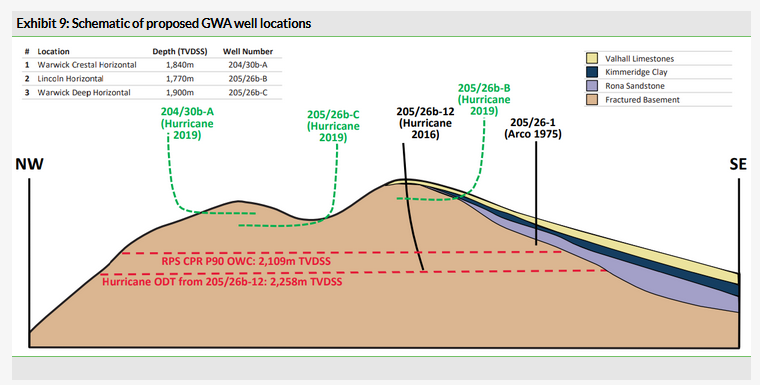
Valuation
We are not making material changes to valuation ahead of EPS phase first oil, with RENAV little changed at 102.3p/share.
Moving parts in our modelling assumptions are highlighted below:
We remove a 5% capex contingency for the Lancaster EPS development.
Updated short-term oil price changes: our short-term Brent assumptions move from $72.8/bbl to $62.8/bbl in FY19, and from $73.7/bbl to $62.0/bbl in FY20, based on EIA forecasts as published in March 2019. Our long-term Brent forecast of $70/bbl from 2022 remains unchanged.
We update our forecasts to reflect reported FY18 results and EPS capex phasing.
Roll-forward of discount date to 1 January 2019.
Key valuation sensitivities include WACC, oil price and, to a lesser extent, opex and capex assumptions. FFD development capex is assumed to be carried under our modelled farm-out scenario.

Financials
Short-term financial forecasts will be driven by timing and initial performance of the Lancaster EPS and as such there will be significant uncertainty in precise forecast of revenues and cash flows for FY19. We expect FY20 to be more reflective of the stabilised cash generation potential of the EPS development phase; the changes highlighted below are largely to our lower short-term oil price expectations.

Below we look at a cash flow bridge, which highlights Hurricane’s potential to fund capital commitments through to end 2021 from a combination of existing cash resources, cash flow from EPS operations, and existing cost-carry arrangements.
We assume conversion of Hurricane’s outstanding 2022 convertible bond ($230m) in our RENAV. If management chooses to refinance this debt instrument in 2022, we believe management will have numerous options including securing debt against the Lancaster EPS through an RBL debt instrument, a new convertible loan or a short-duration corporate bond.
